Toyota Sienna Service Manual: Adjustment
1. VEHICLE PREPARATION FOR HEADLIGHT AIMING ADJUSTMENT
- Prepare the vehicle:
- Ensure there is no damage or deformation to the body around the headlights.
- Fill the fuel tank.
- Make sure that the oil is filled to the specified level.
- Make sure that the coolant is filled to the specified level.
- Inflate the tires to the appropriate pressure.
- Place the spare tire, tools, and jack in their original positions.
- Unload the trunk.
- Sit a person of average weight (68 kg, 150 lb) in the driver's seat.
2. PREPARATION FOR HEADLIGHT AIMING (Using a tester)
- Prepare the vehicle for headlight aim check.
- Adjust in accordance with headlight tester instructions.
3. PREPARATION FOR HEADLIGHT AIMING (Using a screen)
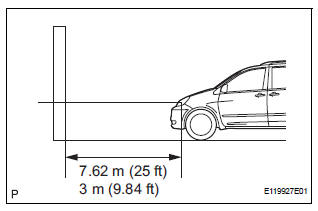
- Prepare the vehicle according to the following conditions:
- Place the vehicle in a location that is dark enough to clearly observe the cutoff line. The cutoff line is a distinct line, below which light from the headlights can be observed and above which it cannot.
- Place the vehicle at a 90 angle to the wall.
- Create a 7.62 m (25 ft) distance between the vehicle (headlight bulb center) and the wall.
- Place the vehicle on a level surface.
- Bounce the vehicle up and down to settle the suspension.
NOTICE: A distance of 7.62 m (25 ft) between the vehicle (headlight bulb center) and the wall is necessary for proper aim adjustment. If unavailable, secure a distance of exactly 3 m (9.84 ft) for check and adjustment. (The target zone will change with the distance so follow the instructions in the illustration.)
- Prepare a piece of thick white paper (approximately 2 m (6.6 ft) (height) x 4 m (13.1 ft) (width)) to use as a screen.
- Draw a vertical line down the center of screen (V line).
- Set the screen as shown in the illustration.
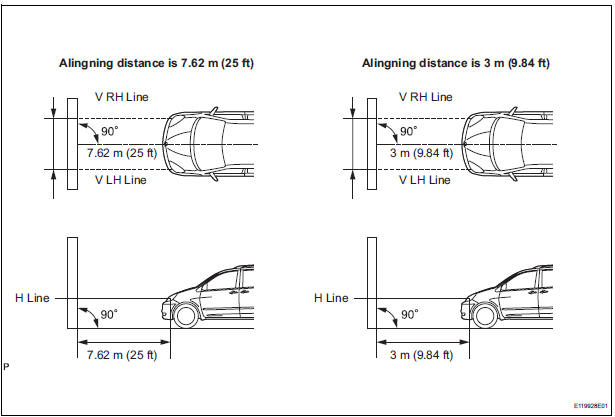
HINT:
- Stand the screen perpendicular to the ground.
- Align the V line on the screen with the center of the vehicle.
- Draw base lines (H line, V LH, V RH lines) on the screen as shown in the illustration.
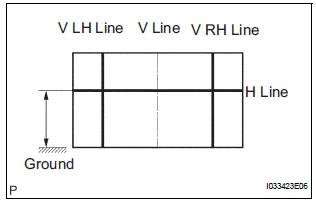
HINT:
- The base lines differ for "low-beam inspection" and "high-beam inspection."
- Mark the headlight bulb center marks on the screen. If the center mark cannot be observed on the headlight, use the center of the headlight bulb or the manufacturer's name marked on the headlight as the center mark.
- H Line (Headlight height): Draw a horizontal line across the screen so that it passes through the center marks. The H line should be at the same height as the headlight bulb center marks of the low-beam headlights.
- V LH Line, V RH Line (Center mark position of left- hand (LH) and right-hand (RH) headlights): Draw two vertical lines so that they intersect the H line at each center mark (aligned with the center of the low-beam headlight bulbs).
4. HEADLIGHT AIMING INSPECTION
- Cover or disconnect the connector of the headlight on the opposite side to prevent light from the headlight not being inspected from affecting headlight aiming inspection.
NOTICE: Do not keep the headlight covered for more than 3 minutes. The headlight lens is made of synthetic resin, and may easily melt or be damaged due to heat.
HINT: When checking the aim of the high-beam, cover the low-beam or disconnect the connector.
- Start the engine.
NOTICE: Engine rpm must be 1,500 or more.
- With headlight leveling switch:
- Set the headlight leveling switch to 0 (zero).
- Turn on the headlight and make sure that the cutoff line falls within the specified area, as shown in the illustration.
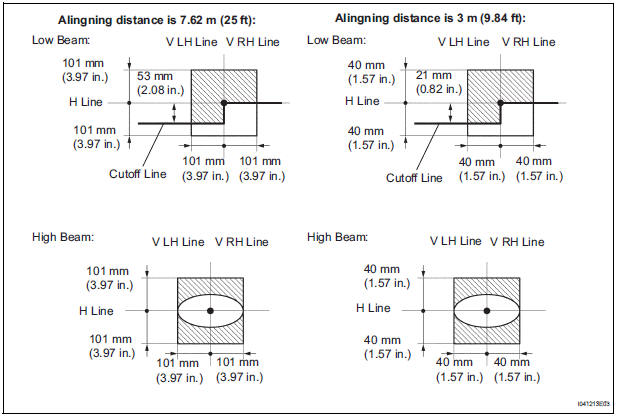
HINT:
- Since the low-beam light and the high-beam light are a unit, if the aim on one is correct, the other should also be correct. However, check both beams just to make sure.
- Alignment distance is 7.62 m (25 ft): The cutoff line is 101 mm (3.97 in.) above and below the H line as well as left and right of the V line with low-beam (SAE J599).
- Alignment distance is 3 m (9.84 ft): The cutoff line is 40 mm (1.57 in.) above and below the H line as well as left and right of the V line with low-beam (SAE J599).
- Alignment distance is 7.62 m (25 ft): The cutoff line is 101 mm (3.97 in.) above and below the H line as well as left and right of the V line with high-beam (SAE J599).
- Alignment distance is 3 m (9.84 ft): The cutoff line is 40 mm (1.57 in.) above and below the H line as well as left and right of the V line with high-beam (SAE J599).
- Alignment distance is 7.62 m (25 ft): The cutoff line is 53 mm (2.08 in.) below the H line with low-beam.
- Alignment distance is 3 m (9.84 ft): The cutoff line is 21 mm (0.82 in.) below the H line with low-beam.
5. HEADLIGHT AIMING ADJUSTMENT
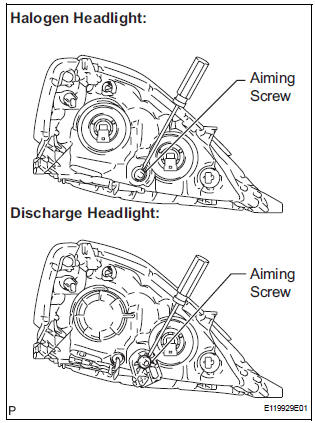
- Adjust the aim vertically: Adjust the headlight aim into the specified range by turning aiming screw A with a screwdriver.
NOTICE: The final turn of the aiming screw should be made in the clockwise direction. If the screw is tightened excessively, loosen it and then retighten it, so that the final turn of the screw is in the clockwise direction.
HINT:
- Perform low-beam aim adjustment.
- The headlight aim moves up when turning the aiming screw clockwise, and moves down when turning the aiming screw counterclockwise.
 Disassembly
Disassembly
1. REMOVE NO. 1 HEADLIGHT BULB (HALOGEN HEADLIGHT)
Turn in the direction indicated by the arrow and
remove the No. 1 headlight bulb.
2. REMOVE DISCHARGE HEADLIGHT BULB (DISCHARGE HE ...
 Reassembly
Reassembly
1. INSTALL LIGHT CONTROL ECU (DISCHARGE HEADLIGHT)
Install a new headlight leveling motor base packing.
Install the headlight leveling motor assembly as
shown in the illustrati ...
Other materials:
Center Airbag Sensor Assembly Communication
Circuit Malfunction
DTC B1790 Center Airbag Sensor Assembly Communication
Circuit Malfunction
DESCRIPTION
The center airbag sensor assembly communication circuit consists of the
occupant classification ECU and
the center airbag sensor assembly.
DTC B1790 is recorded when a malfunction is detected in the center ...
Transmission Fluid Temperature Sensor "A"
DESCRIPTION
The ATF (Automatic Transmission Fluid) temperature sensor converts the fluid
temperature into a
resistance value which is input into the ECM.
The ECM applies a voltage to the temperature sensor through ECM terminal THO1.
The sensor resistance changes with the transmission f ...
Precaution
NOTICE:
Because the compressor operates at high voltages, wear
electric insulated gloves and pull out the service plug to
cut the high-voltage circuit before inspection.
1. DO NOT HANDLE REFRIGERANT IN AN ENCLOSED AREA OR NEAR AN OPEN FLAME
2. ALWAYS WEAR EYE PROTECTION
3. BE CAREFUL NOT T ...
